 W
WThe Hemerobiiformia are a suborder of insects in the order Neuroptera. The phylogeny of the Neuroptera was explored in 2014 using mitochondrial DNA sequences. The results indicate that the traditional Hemerobiiformia are paraphyletic, meaning that not all the members of the clade are considered to belong to it, in particular since it would include all the Myrmeleontiformia, with which the Hemerobiiformia were traditionally contrasted. The Osmyloidea, usually included in Hemerobiiformia, actually seem to represent a more ancient lineage basal to Hemerobiiformia as well as Myrmeleontiformia. The broken-up group is shown in the cladogram:
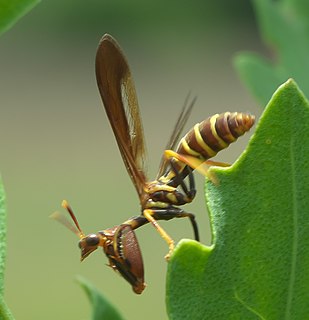 W
WClimaciella is a genus of wasp mantidflies in the family Mantispidae. There are about 10 described species in Climaciella, found in North, Central, and South America. Climaciella brunnea, a wasp mimic, is a common species found in Central and North America.
 W
WDicromantispa is a genus of mantidflies in the family Mantispidae. There are about 10 described species in Dicromantispa.
 W
WDicromantispa interrupta is a species of mantidfly in the family Mantispidae. It is found in Central America and North America.
 W
WDicromantispa sayi is a species of mantidfly in the family Mantispidae. It is found in the Caribbean Sea, Central America, and North America.
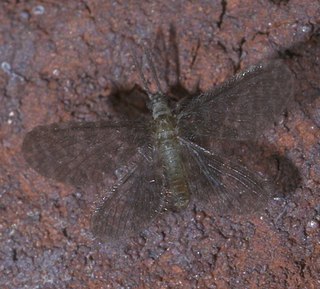 W
WDilaridae is a family of insects in the order Neuroptera, known as "pleasing lacewings". They were formerly placed in the superfamily Hemerobioidea. But it seems that the Dilaridae are a rather basal member of the Mantispoidea, which includes among others the mantidflies (Mantispidae), whose peculiar apomorphies belie that their relationship to the pleasing lacewings is apparently not at all distant.
 W
WDrepanacra is a genus of lacewings belonging to the family Hemerobiidae.
 W
WDrepanacra binocula, known as the Australian variable lacewing, is a species of brown lacewing in the family Hemerobiidae, found across Australia and New Zealand, including Lord Howe Island, Norfolk Island and the Kermadec Islands.
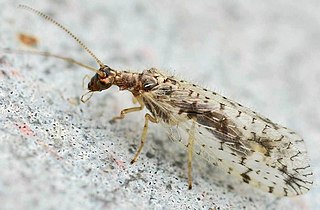 W
WHemerobiidae is a family of Neuropteran insects commonly known as brown lacewings, comprising about 500 species in 28 genera. Most are yellow to dark brown, but some species are green. They are small; most have forewings 4–10 mm long. These insects differ from the somewhat similar Chrysopidae not only by the usual coloring but also by the wing venation: hemerobiids differ from chrysopids in having numerous long veins and forked costal cross veins. Some genera are widespread, but most are restricted to a single biogeographical realm. Some species have reduced wings to the degree that they are flightless. Imagines (adults) of subfamily Drepanepteryginae mimic dead leaves. Hemerobiid larvae are usually less hairy than chrysopid larvae.
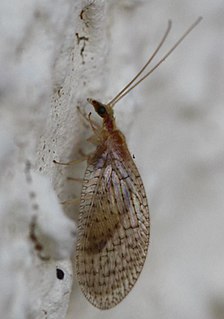 W
WHemerobiinae is a subfamily of brown lacewings in the family Hemerobiidae. There are about 5 genera and at least 60 described species in Hemerobiinae.
 W
WHemerobiidae is a family of Neuropteran insects commonly known as brown lacewings, comprising about 500 species in 28 genera. Most are yellow to dark brown, but some species are green. They are small; most have forewings 4–10 mm long. These insects differ from the somewhat similar Chrysopidae not only by the usual coloring but also by the wing venation: hemerobiids differ from chrysopids in having numerous long veins and forked costal cross veins. Some genera are widespread, but most are restricted to a single biogeographical realm. Some species have reduced wings to the degree that they are flightless. Imagines (adults) of subfamily Drepanepteryginae mimic dead leaves. Hemerobiid larvae are usually less hairy than chrysopid larvae.
 W
WHemerobius is a genus of lacewings in the family Hemerobiidae. It is found throughout Europe and North America. Like most lacewings, both the larvae and adults are predatory, primarily eating acarines, scale insects, psyllids, aphids, thrips, and the eggs of lepidopterans and whiteflies.Names brought to synonymyHemerobius elegans Stephens, 1836 Hemerobius elegans Guérin-Méneville, 1844
 W
WHemerobius humulinus is a species of brown lacewing in the family Hemerobiidae. It is found in Europe and Northern Asia, North America, and Southern Asia.
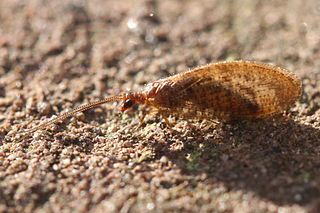 W
WHemerobius stigma is a species of brown lacewing in the family Hemerobiidae. It is found in Europe and Northern Asia and North America. The species was introduced to New Zealand to prey on adelgidae growing on pine plantations, and was first noted as being present in the country in 1935, however was not able to be established.
 W
WLeptomantispa is a genus of mantidflies in the family Mantispidae. There are about seven described species in Leptomantispa.
 W
WLeptomantispa pulchella is a species of mantidfly in the family Mantispidae. It is found in the Caribbean Sea, Central America, and North America.
 W
WLomamyia is a genus of beaded lacewings in the family Berothidae. There are about 11 described species in Lomamyia.
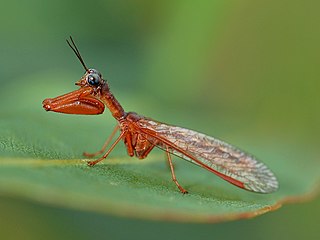 W
WMantispinae is a subfamily of mantidflies in the family Mantispidae. There are at least 30 genera and 310 described species in Mantispinae.
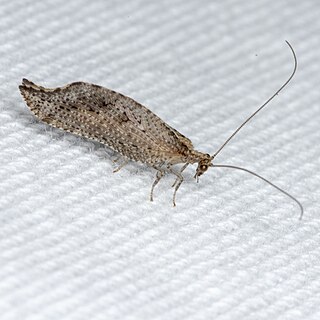 W
WMegalomina is an insect genus from the family of brown lacewings (Hemerobiidae), which belongs to the order Neuroptera. The scientific name of the genus is validly published for the first time by Nathan Banks in 1909.
 W
WMegalomus is a genus of brown lacewings in the family Hemerobiidae. There are more than 40 described species in Megalomus.
 W
WMegalomus hirtus, common name bordered brown lacewing, is a species of brown lacewings in the family Hemerobiidae.
 W
WMegalomus tortricoides is a species of brown lacewing in the family Hemerobiidae. It was first described by Rambur in 1842.
 W
WMicromus is a genus of lacewings in the family Hemerobiidae. These small insects are found worldwide. Like most lacewings, both the larvae and adults are predatory, primarily eating acarines, scale insects, psyllids, aphids, thrips, and the eggs of lepidopterans and whiteflies. The species Micromus tasmaniae has been mass-bred for biological pest control in Australia.
 W
WMicromus angulatus is a species of brown lacewing in the family Hemerobiidae. It is found in Africa, Europe and Northern Asia, North America, and Southern Asia.
 W
WMicromus bifasciatus, is a species of Australasian brown lacewing in the family Hemerobiidae that was first described by Robert John Tillyard in 1923.
 W
WMicromus posticus is a species of brown lacewing in the family Hemerobiidae. It is found in the Caribbean, Central America, and North America.
 W
WMicromus subanticus is a species of brown lacewing in the family Hemerobiidae. It is found in the Caribbean, Europe and Northern Asia, Central America, and North America.
 W
WMicromus tasmaniae, known as the Tasmanian brown lacewing, is a species of brown lacewing in the family Hemerobiidae. It is widespread in Australia, New Zealand, and Pacific Islands such as New Caledonia and Vanuatu.
 W
WMicromus variegatus is a species of brown lacewing in the family Hemerobiidae. It is found in Europe and Northern Asia and North America.
 W
WMicromus variolosus is a species of brown lacewing in the family Hemerobiidae. It is found in North America.
 W
WNallachius is a genus of pleasing lacewings in the family Dilaridae. There are more than 20 described species in Nallachius.
 W
WNallachius americanus is a species of pleasing lacewing in the family Dilaridae. It is found in the Caribbean Sea, North America, and South America.
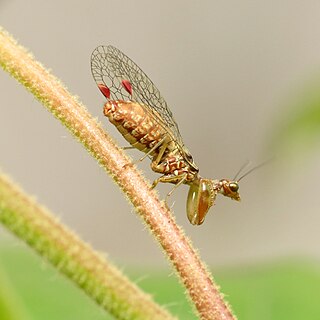 W
WNolima dine is a species of mantidfly in the family Mantispidae.
 W
WNusalala is a genus of brown lacewings. The scientific name was published in 1913 by Longinos Navás. They belong to the subfamily Microminae, as well as the genera Micromus and Megalomina. Some species of this genus, such as Nusalala brachyptera, are "brachypter" meaning short wings, and have lost the ability to fly; they can only jump. This phenomenon has evolved in a number of genera in the family Hemerobiidae
 W
WProtobiella zelandica is a species of New Zealand beaded lacewing in the family Berothidae that was first described by Robert John Tillyard in 1923. It is the sole endemic species in Berothidae found in New Zealand. No subspecies are noted in the Catalogue of Life.
 W
WPsectra is a genus of brown lacewings in the family Hemerobiidae. There are more than 20 described species in Psectra.
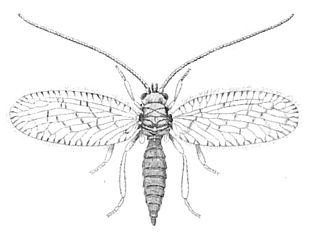 W
WPsectra diptera is a species of brown lacewing in the family Hemerobiidae. It is found in Europe and Northern Asia and North America.
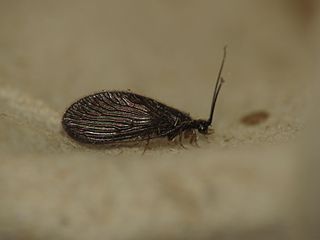 W
WSisyra is a genus of lacewings in the family Sisyridae. There are at least 8 described species in Sisyra.
 W
WSisyra nigra is a species of spongillafly in the family Sisyridae. It is found in Europe and Northern Asia and North America.
 W
WSympherobius is a genus of brown lacewings in the family Hemerobiidae. There are at least 50 described species in Sympherobius.
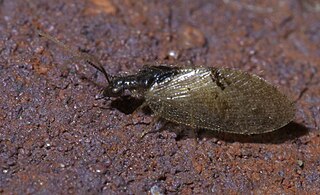 W
WSympherobius barberi, or Barber's brown lacewing, is a species of brown lacewing in the family Hemerobiidae. It is found in Europe and Northern Asia, Central America, North America, Oceania, and South America. The species was introduced to New Zealand to prey on aphids and mealybugs, first noted in 1936, however was not able to be established.
 W
WSympherobius elegans is a species of lacewings.
 W
WWesmaelius is a genus of net-winged insects, belonging to the family Hemerobiidae.
 W
WZeugomantispa is a genus of mantidflies in the family Mantispidae. There are at least three described species in Zeugomantispa.
 W
WZeugomantispa minuta, the green mantisfly, is a species of mantidfly in the family Mantispidae. It is found in the Caribbean Sea, Central America, North America, and South America.